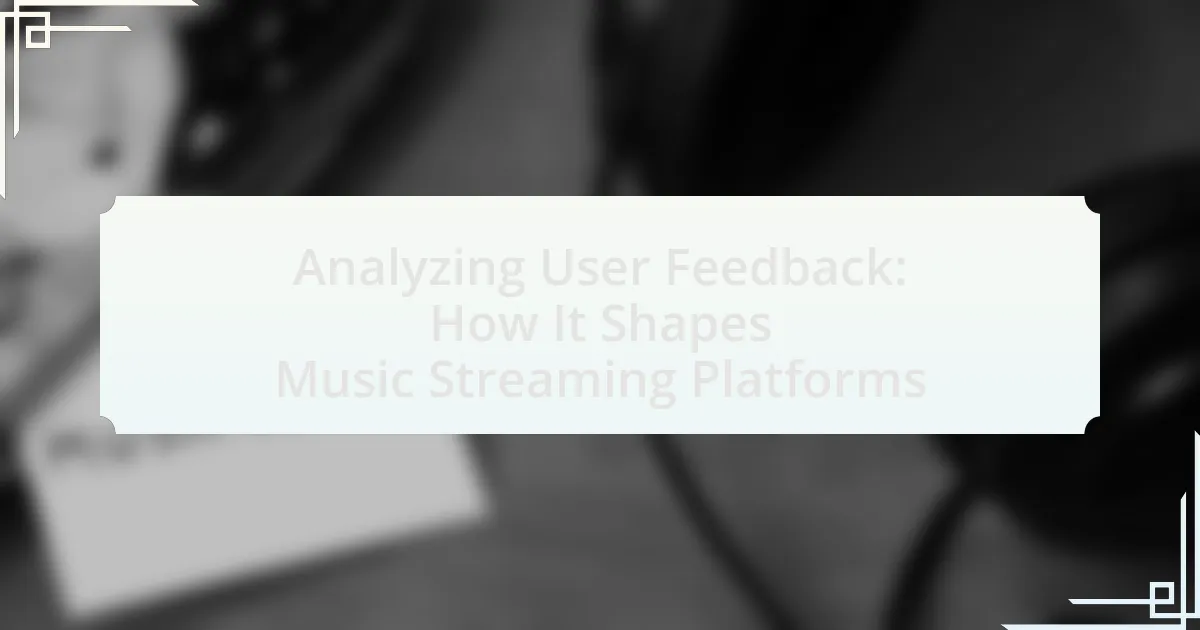User feedback plays a critical role in shaping music streaming platforms by providing insights into user preferences, satisfaction, and areas for improvement. The article explores how platforms like Spotify and Apple Music collect feedback through surveys, ratings, and reviews, which directly influence feature enhancements, content recommendations, and user interface design. It highlights the importance of user feedback in driving user retention and engagement, as well as the challenges platforms face in analyzing diverse and voluminous data. Additionally, the article discusses best practices for effective feedback analysis and strategies to foster a more engaged user community, ultimately emphasizing the significance of user insights in the evolution of music streaming services.

What is User Feedback in the Context of Music Streaming Platforms?
User feedback in the context of music streaming platforms refers to the opinions, ratings, and comments provided by users regarding their experiences with the service. This feedback is crucial as it informs platform developers about user preferences, satisfaction levels, and areas needing improvement. For instance, a study by the International Journal of Information Management found that user feedback significantly influences the development of personalized recommendation algorithms, enhancing user engagement and retention.
How is user feedback collected on music streaming platforms?
User feedback on music streaming platforms is collected through various methods, including surveys, in-app ratings, and user reviews. These platforms often implement pop-up surveys after listening sessions to gauge user satisfaction and preferences. Additionally, users can rate songs and playlists, providing direct feedback on their experiences. User reviews and comments on tracks or albums also serve as qualitative data, allowing platforms to analyze trends and sentiments. This systematic collection of feedback helps platforms refine their algorithms and improve user experience, as evidenced by Spotify’s use of user data to enhance personalized playlists and recommendations.
What methods are used to gather user feedback?
Surveys and questionnaires are commonly used methods to gather user feedback. These tools allow music streaming platforms to collect quantitative and qualitative data directly from users regarding their experiences, preferences, and suggestions. For instance, a survey might ask users to rate their satisfaction with specific features or to provide open-ended comments about their overall experience. This method is effective because it can reach a large audience quickly and can be analyzed statistically to identify trends and areas for improvement.
How do user surveys influence platform features?
User surveys significantly influence platform features by providing direct insights into user preferences and needs. These surveys collect quantitative and qualitative data that help developers prioritize feature enhancements, identify pain points, and understand user behavior. For instance, a survey may reveal that users desire a more personalized playlist feature, prompting the platform to allocate resources towards developing algorithms that enhance personalization. Research indicates that platforms that actively incorporate user feedback into their development processes see higher user satisfaction and retention rates, as evidenced by a study from the Nielsen Norman Group, which found that user-centered design leads to a 50% increase in user engagement.
Why is user feedback important for music streaming platforms?
User feedback is crucial for music streaming platforms because it directly influences content curation, user experience, and platform improvements. By analyzing user preferences and behaviors, platforms can tailor their offerings to better meet listener demands, leading to increased user satisfaction and retention. For instance, a study by the International Journal of Information Management found that platforms utilizing user feedback effectively saw a 20% increase in user engagement. This demonstrates that incorporating user insights not only enhances the service but also drives growth and competitiveness in the market.
What impact does user feedback have on user retention?
User feedback significantly enhances user retention by allowing platforms to tailor their services to meet user needs. When music streaming platforms actively solicit and implement user feedback, they create a more personalized experience, which increases user satisfaction and loyalty. For instance, a study by McKinsey & Company found that companies that prioritize customer feedback can improve retention rates by up to 10%. This correlation indicates that responsive platforms not only retain users but also foster a community that feels valued and heard, ultimately leading to sustained engagement and reduced churn rates.
How does user feedback shape content recommendations?
User feedback shapes content recommendations by providing data on user preferences and behaviors, which algorithms analyze to tailor suggestions. For instance, when users rate songs or create playlists, this information is aggregated to identify trends and patterns in listening habits. Research shows that platforms like Spotify utilize collaborative filtering techniques, where user feedback directly influences the recommendation engine, enhancing the relevance of suggested content. This method has been validated by studies indicating that personalized recommendations based on user interactions can increase user engagement by up to 30%.

How Does User Feedback Influence the Development of Music Streaming Platforms?
User feedback significantly influences the development of music streaming platforms by guiding feature enhancements, user interface design, and content curation. Platforms like Spotify and Apple Music actively collect user feedback through surveys, app reviews, and usage analytics, which helps them identify user preferences and pain points. For instance, Spotify’s introduction of personalized playlists, such as Discover Weekly, was a direct response to user requests for tailored music recommendations. Additionally, a study by the International Journal of Information Management found that user feedback directly correlates with increased user satisfaction and retention rates, demonstrating its critical role in shaping platform evolution.
What changes have been made to platforms based on user feedback?
Music streaming platforms have implemented various changes based on user feedback, including enhanced user interfaces, improved recommendation algorithms, and the introduction of new features like collaborative playlists. For instance, Spotify revamped its interface to simplify navigation and incorporated user-requested features such as the “Discover Weekly” playlist, which was developed in response to user desires for personalized music discovery. Additionally, Apple Music adjusted its library organization and added features like lyrics display, directly addressing user requests for a more engaging listening experience. These modifications demonstrate how platforms actively adapt to user input to enhance satisfaction and usability.
How have user suggestions led to new features?
User suggestions have directly influenced the development of new features in music streaming platforms by providing insights into user preferences and pain points. For instance, platforms like Spotify and Apple Music regularly analyze feedback from their user communities to identify desired functionalities, such as personalized playlists or enhanced search capabilities. This feedback loop has led to the implementation of features like Spotify’s Discover Weekly, which curates music based on listening habits, demonstrating a clear response to user requests for tailored experiences. Additionally, user suggestions have prompted improvements in user interface design and the introduction of social sharing options, further validating the importance of user input in shaping platform evolution.
What role does user feedback play in interface design?
User feedback plays a critical role in interface design by informing designers about user preferences, pain points, and usability issues. This feedback allows designers to make data-driven decisions that enhance user experience and satisfaction. For instance, a study by Nielsen Norman Group found that usability testing, which incorporates user feedback, can lead to a 50% increase in user satisfaction and engagement. By continuously integrating user feedback into the design process, platforms can adapt their interfaces to better meet user needs, ultimately leading to improved retention and usage rates.
How do music streaming platforms prioritize user feedback?
Music streaming platforms prioritize user feedback by implementing algorithms that analyze user interactions, preferences, and ratings to enhance user experience. These platforms utilize data analytics to track listening habits, song skips, and playlist additions, allowing them to identify trends and preferences among users. For instance, Spotify employs machine learning models to curate personalized playlists like Discover Weekly, which are directly influenced by user feedback and listening behavior. Additionally, platforms often conduct surveys and monitor social media to gather qualitative feedback, ensuring they adapt features and content to meet user demands effectively. This data-driven approach not only improves user satisfaction but also drives engagement and retention rates.
What criteria are used to evaluate user suggestions?
User suggestions are evaluated based on relevance, feasibility, user impact, and alignment with strategic goals. Relevance assesses how closely the suggestion addresses current user needs or platform issues. Feasibility examines the technical and resource requirements for implementation. User impact measures the potential effect on user experience and satisfaction. Alignment with strategic goals ensures that the suggestion supports the platform’s long-term vision and objectives. These criteria help prioritize suggestions that can enhance the overall service and user engagement effectively.
How do platforms balance user feedback with business goals?
Platforms balance user feedback with business goals by integrating user insights into their strategic decision-making processes while ensuring profitability. For instance, music streaming services often analyze user data to identify popular features or content preferences, which informs their product development and marketing strategies. This approach allows platforms to enhance user satisfaction and retention, ultimately driving revenue growth. A study by PwC indicates that companies prioritizing customer experience can achieve revenue growth rates of 4-8% higher than their competitors, demonstrating the effectiveness of aligning user feedback with business objectives.

What Challenges Do Music Streaming Platforms Face in Analyzing User Feedback?
Music streaming platforms face significant challenges in analyzing user feedback, primarily due to the volume and diversity of data. The sheer amount of feedback generated by millions of users can overwhelm analytical systems, making it difficult to identify meaningful patterns or trends. Additionally, user feedback often varies widely in format, including text reviews, ratings, and social media comments, complicating the analysis process.
Furthermore, the subjective nature of music preferences means that feedback can be highly personal and context-dependent, leading to inconsistencies in interpretation. For instance, a user may express dissatisfaction with a song due to personal taste rather than objective quality, which can skew data analysis.
Moreover, the presence of noise in the feedback, such as spam or irrelevant comments, can further hinder accurate analysis. According to a report by Deloitte, 70% of user-generated content on platforms can be considered irrelevant or unhelpful, emphasizing the need for advanced filtering techniques to extract valuable insights.
These challenges necessitate the use of sophisticated algorithms and machine learning techniques to effectively process and interpret user feedback, ensuring that music streaming platforms can adapt and improve their services based on accurate data.
What are the common pitfalls in interpreting user feedback?
Common pitfalls in interpreting user feedback include confirmation bias, overgeneralization, and neglecting context. Confirmation bias occurs when analysts favor information that supports their pre-existing beliefs, leading to skewed interpretations. Overgeneralization happens when feedback from a small sample is applied to the entire user base, which can misrepresent the overall sentiment. Neglecting context means failing to consider the circumstances under which feedback was given, which can distort the meaning of the comments. These pitfalls can result in misguided decisions that do not accurately reflect user needs or preferences.
How can bias affect the analysis of user feedback?
Bias can significantly distort the analysis of user feedback by leading to skewed interpretations and decisions. When analysts have preconceived notions or preferences, they may selectively focus on feedback that confirms their beliefs while disregarding contradictory information. For instance, a study by the Pew Research Center found that confirmation bias can lead to misinterpretations of data, as analysts may unconsciously prioritize positive reviews over negative ones, resulting in an inaccurate representation of user sentiment. This misrepresentation can ultimately affect product development and user experience on music streaming platforms, as decisions may be based on incomplete or biased data rather than a comprehensive understanding of user needs.
What challenges arise from conflicting user opinions?
Conflicting user opinions create challenges in decision-making for music streaming platforms. These challenges include difficulty in prioritizing features, as differing user preferences can lead to indecision on which updates to implement. Additionally, conflicting feedback can result in user dissatisfaction, as platforms may struggle to meet the diverse needs of their audience. This situation can also complicate marketing strategies, as messaging must appeal to a broad range of opinions, potentially alienating certain user segments. Furthermore, the presence of polarized opinions can hinder community engagement, as users may feel less inclined to participate in discussions when they perceive a lack of consensus.
How can music streaming platforms improve their feedback analysis processes?
Music streaming platforms can improve their feedback analysis processes by implementing advanced natural language processing (NLP) techniques to analyze user comments and reviews more effectively. By utilizing sentiment analysis algorithms, platforms can categorize feedback into positive, negative, and neutral sentiments, allowing for a clearer understanding of user satisfaction. For instance, a study by Liu (2012) highlights that sentiment analysis can enhance the extraction of user opinions from large datasets, leading to actionable insights. Additionally, integrating machine learning models can help in identifying trends and patterns in user feedback over time, enabling platforms to adapt their services based on user preferences. This approach not only streamlines the feedback analysis process but also enhances user engagement by demonstrating responsiveness to user needs.
What tools and technologies can enhance feedback analysis?
Natural Language Processing (NLP) tools and machine learning algorithms can significantly enhance feedback analysis. These technologies enable the automatic extraction of insights from user comments and reviews, allowing platforms to identify trends and sentiments effectively. For instance, sentiment analysis tools like VADER and TextBlob can quantify user emotions, while topic modeling techniques such as Latent Dirichlet Allocation (LDA) can uncover prevalent themes in feedback. Additionally, data visualization tools like Tableau and Power BI can present these insights in an easily digestible format, facilitating better decision-making. The integration of these tools allows music streaming platforms to adapt their services based on user preferences, ultimately improving user satisfaction and engagement.
How can platforms foster a more engaged user feedback community?
Platforms can foster a more engaged user feedback community by implementing structured feedback mechanisms and actively responding to user input. Structured feedback mechanisms, such as surveys, polls, and dedicated feedback forums, allow users to share their thoughts in an organized manner, increasing the likelihood of participation. Actively responding to user input demonstrates that the platform values user opinions, which can enhance user trust and encourage further engagement. Research indicates that platforms that prioritize user feedback see a 20% increase in user retention, as users feel more connected and invested in the platform’s development.
What Best Practices Should Music Streaming Platforms Follow for Effective User Feedback Analysis?
Music streaming platforms should implement systematic categorization, real-time feedback collection, and data-driven decision-making for effective user feedback analysis. Systematic categorization involves organizing feedback into themes such as user experience, content preferences, and technical issues, which allows for easier identification of trends and areas for improvement. Real-time feedback collection can be achieved through in-app surveys and user ratings, enabling platforms to capture user sentiments promptly and respond to issues as they arise. Data-driven decision-making ensures that platforms utilize analytics tools to interpret feedback quantitatively, allowing for informed adjustments to features and services. Research indicates that platforms employing these practices can enhance user satisfaction and retention, as evidenced by a study from the Journal of Interactive Marketing, which found that companies leveraging user feedback effectively saw a 20% increase in customer loyalty.
How can platforms ensure they are responsive to user feedback?
Platforms can ensure they are responsive to user feedback by implementing systematic feedback collection mechanisms, such as surveys, user interviews, and feedback forms. These methods allow platforms to gather insights directly from users about their experiences and preferences. For instance, Spotify utilizes in-app surveys to solicit user opinions on features and content, which helps them prioritize updates and improvements based on actual user needs. Additionally, platforms can analyze user behavior data alongside feedback to identify trends and areas for enhancement, ensuring that changes align with user expectations. This approach not only fosters user engagement but also demonstrates a commitment to continuous improvement, ultimately leading to higher user satisfaction and retention.
What strategies can be implemented to encourage more user feedback?
To encourage more user feedback, music streaming platforms can implement strategies such as incentivizing feedback through rewards, simplifying the feedback process, and actively engaging users through personalized communication. Incentivizing feedback can include offering discounts, exclusive content, or entry into contests, which has been shown to increase participation rates. Simplifying the feedback process by using quick surveys or rating systems reduces barriers for users, making it easier for them to share their thoughts. Additionally, actively engaging users through personalized emails or notifications that ask for their opinions on recent features or playlists fosters a sense of community and encourages more frequent feedback. These strategies are supported by research indicating that user engagement increases when feedback mechanisms are user-friendly and rewarding.

Leave a Reply